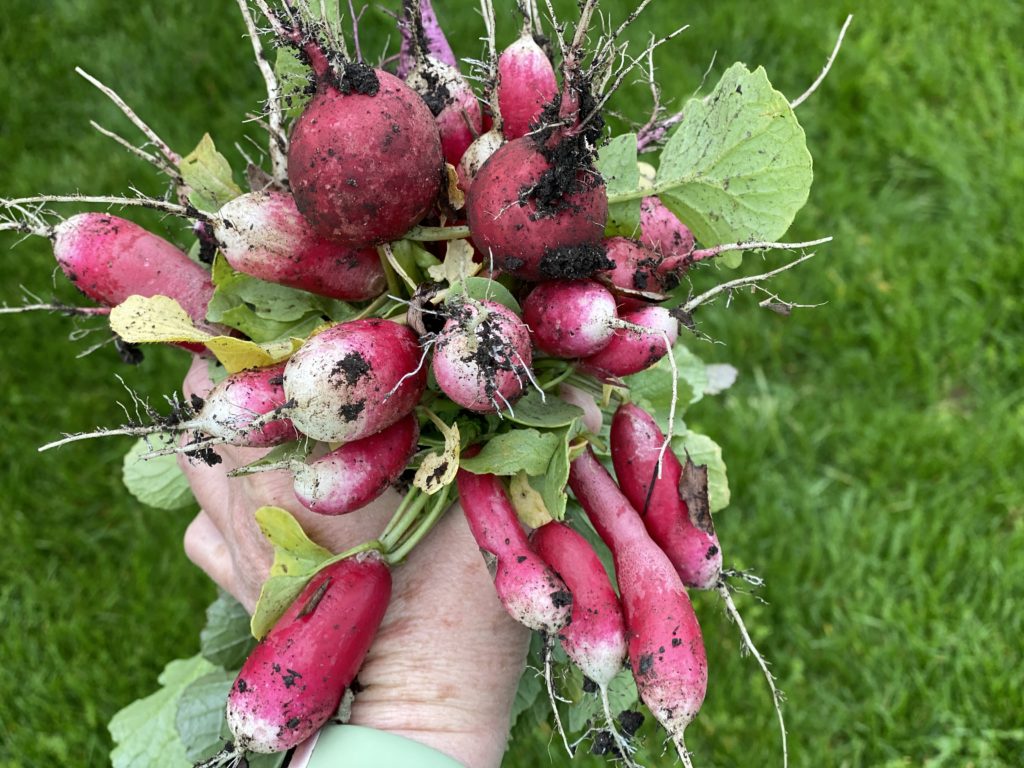While pulling out some radishes, it occurred to me that new gardeners—really all gardeners—might find it useful to understand the language of harvesting.

So with five minutes of thought, I present my treatise on the language of harvesting.
Let me say first and foremost, one can harvest anything and not be wrong in referring to it as harvesting, though there is a specific use of the word “harvesting” that we will get to in a bit. But why harvest when you can pick, pluck, and pull?
And what is the difference in these harvesting terms?
We’ll begin with “pull.” I pulled out my radishes, meaning I pulled them out of the ground, and once pulled, they were no longer growing, One pull, one radish. Done. This is true for most root crops. We pull out carrots, beets, parsnips, turnips, and radishes—to name a few common root crops—and leave no plant behind.
However, speaking of root crops, we do not pull potatoes. We dig them out. So add dig to your list of harvest words. To harvest potatoes, you need to dig them out of the ground. The same is true of sweet potatoes. You can’t just grasp the plant by its stem and pull it out. You’ll end up with nothing. So you dig those tubers out.
Now that you’ve mastered pull and dig, we’ll go on to pick and pluck, which can also be confused.
We pick tomatoes, beans and peas, meaning we twist or cut them away from the plant, leaving the plant intact so it can continue to grow and flower and produce more of what we picked.
This is closely related to pluck, as you can imagine, and I won’t cringe if you pluck a cherry tomato or two while out in your garden, but I’d prefer you pick them and pluck a few leaves off your spinach, kale and lettuce plants. That’s right, we reserve pluck for the removal of edible leaves or other non-fruit bearing parts of plant. You pluck a bit of kale for a salad. But if you decide to pick a bit of kale, I won’t blow the gardener’s referee whistle on you and yell “wrong.”
What about snip, you ask? Do we sometimes snip instead of pluck? Absolutely. We snip bits of herbs when we want to use them, as in we snip a few leaves off the basil to add to a lovely salad we made by picking a few tomatoes. Snipping usually involves using little clippers or scissors so we don’t tear up the plant with plucking. I can’t imagine plucking tomatoes, then also plucking basil. It just isn’t done. You pick tomatoes and then snip basil when using both in a salad.
I will admit, however, that the use of pick over pluck or pluck over pick sometimes depends on your harvesting mood. The more excited you are, the more you tend to pluck instead of pick. I might inadvertently pluck a cherry tomato from its vine when I am excited to see the first one ready to harvest, but when there are loads and loads of them all ripe and ready to eat, I choose to pick them.
Which leads us right back to harvest. When do we harvest? We often harvest when we are taking the last of a crop, such as sweet corn, and know there will be no more. So it is often used with pick, pluck, pull, and even dig especially later in the season when we are picking, plucking, pulling, and digging those vegetable for the last time. Let us harvest our potatoes by digging them out. Let us harvest our sweet corn by pulling the ears.
Wait, what? We pulled the ears of corn instead of picking them. Isn’t pulling just for root crops? Well, yes, pulling is primarily for root crops with the exception of corn which can be either picked or pulled. “Pulled” because the action of picking corn involves pulling down on the ear of corn and then twisting it off.
So there you have it. The language of the harvest explained. Go forth now and freely gather your harvest… wait, did I just add another harvest word? Gather. I think I did. We gather when we pick, pluck, pull, dig up, snip, and otherwise harvest a big variety of fruits and vegetables at one time. This is often done right before the first frost in the fall, but is also done at the height of summer when everything seems to be ready to harvest all at once.
So now there you have it. Go forth and freely pick, pluck, pull, dig, snip, harvest, and gather your bounty, with a smile on your face because you are growing your own vegetables, and you know how to properly describe what it is you are doing out there in your garden.


I planted watermelon radishes this year. I haven’t harvested, yet
Thank you so much for sharing this information. I’m a beginner,
and learning these terms has helped me in a great way!
Would love to learn more. Found this very helpful. Perhaps providing a picture with each term could help make the undertaking more clear as in the picture with the radishes. I will look up now what “plucking” looks like (English my second language and I’m just barely starting to understand the gardeners language.) Overall, I found this article very helpful. Thank you for taking the time to write this to help others in understanding.